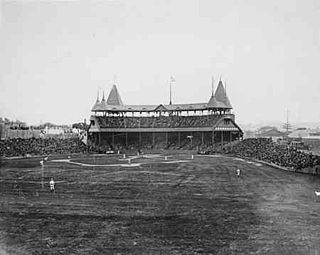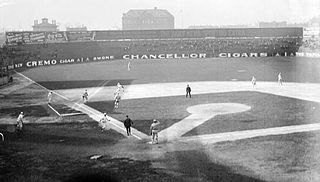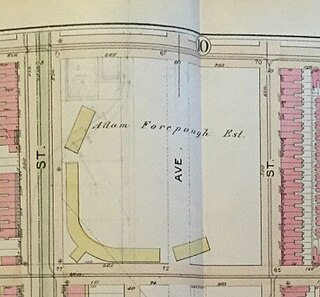
Lloyd Street Grounds was a baseball park located in Milwaukee, Wisconsin. It was used by two different professional baseball clubs during 1895–1903.

The Baltimore Orioles were a 19th-century professional baseball team that competed from 1882 to 1899, first in the American Association and later in the National League. This early Orioles franchise, which featured six players and a manager who were later inducted to the National Baseball Hall of Fame, finished in first place for three consecutive seasons (1894–1896) and won the Temple Cup national championship series in 1896 and 1897.

National League Park, commonly referred to as the Baker Bowl after 1923, was a baseball stadium and home to the Philadelphia Phillies from 1887 until 1938, and first home field of the Philadelphia Eagles from 1933 to 1935. It opened in 1887 with a capacity of 12,500, burned down in 1894, and was rebuilt in 1895 as the first ballpark constructed primarily of steel and brick, and first with a cantilevered upper deck. The ballpark's first base line ran parallel to Huntingdon Street; right field to center field parallel to North Broad Street; center field to left field parallel to Lehigh Avenue; and the third base line parallel to 15th Street. The stadium was demolished in 1950.

South End Grounds refers to any one of three baseball parks on one site in Boston, Massachusetts. They were home to the franchise that eventually became known as the Boston Braves, first in the National Association and later in the National League, from 1871 through part of the 1914 season. That stretch of 43 1/2 seasons is still the longest tenure of the Braves club at any of their various ballparks and cities since 1914.

South Side Park was the name used for three different baseball parks that formerly stood in Chicago, Illinois, at different times, and whose sites were all just a few blocks away from each other.

Washington Park was the name given to three Major League Baseball parks on two different sites in the Park Slope neighborhood of Brooklyn, New York, located at the intersection of Third Street and Fourth Avenue. The two sites were diagonally opposite each other, on the southeast and northwest corners.
23rd Street Grounds, also known as State Street Grounds and 23rd Street Park, and sometimes spelled out as Twenty-third Street Grounds, was a ballpark in Chicago, in what is now the Chinatown district. In this ballpark, the Chicago White Stockings played baseball from 1874 to 1877, the first two years in the National Association and the latter two in the National League.
Newington Park was a baseball grounds in Baltimore, Maryland. It was home to the Lord Baltimore baseball club of the National Association from 1872 to 1874 and to the Baltimore Orioles of the American Association for the 1882 season. There are apparently no surviving photographs of the grounds. Its location was on Pennsylvania Avenue "extended," on the northwest side of West Baltimore.

Recreation Park was a baseball park in Philadelphia.

Abell is a neighborhood located in the north-central area of Baltimore, Maryland, United States. It is considered to be part of Charles Village, Baltimore.
League Park was a Major League baseball park located in Cincinnati, Ohio, United States. It was the home of the Cincinnati Reds from 1884 through 1901. The ballpark was on an asymmetrical block bounded by Findlay Street (south), Western Avenue, York Street (north) and McLean Avenue (west).

Forepaugh Park was a baseball ground located in Philadelphia, Pennsylvania, at Broad and Dauphin Streets in North Philadelphia. It had an estimated capacity of 5,000. The ground was home to the Philadelphia Quakers of the Players' League in 1890 and the American Association in 1891. The ballpark featured a bicycle track and was a popular velodrome in Philadelphia in the early 1890s. The ballpark was owned by and named for Adam Forepaugh and the grounds used for circuses and various types of exhibitions until 1894. The property was sold for development and residences constructed in 1895.

East End Park was a former major league baseball park located in the East End neighborhood of Cincinnati in the United States. The ballpark, which is also known to baseball historians as Pendleton Park, was home to the Cincinnati Reds of the American Association during the 1891 baseball season. The club was led by the flamboyant star, Mike "King" Kelly.
The Roanoke Red Sox was a primary name of the minor league baseball teams based in Roanoke, Virginia. Between 1894 and 1953, Roanoke teams played as members of the Virginia League and Piedmont League (1943–1953), winning five league championships and one pennant. Roanoke teams were a minor league affiliate of the Cleveland Indians in 1940 and Boston Red Sox from 1943 to 1953. Baseball Hall of Fame members Jack Chesbro (1896) and Heinie Manush (1943) played for Roanoke.

Oriole Park was the name of multiple baseball parks in Baltimore, Maryland, all built within a few blocks of each other.

Harwood is a small neighborhood located in the north-central area of Baltimore, Maryland, USA. It sits east of Charles Village, south of Abell, west of Waverly and north of Barclay. Its boundaries are Guilford and Greenmount Avenues to the east and west, and 25th and 29th streets to the north and south. These streets together encompass about 14 city blocks.

Oriole Park (V) is the name used by baseball historians to designate the longest-lasting of several former major league and minor league baseball parks in Baltimore, Maryland, each one named Oriole Park.
The Omaha Packers were a minor league baseball team based in Omaha, Nebraska. Between 1879 and 1935, Omaha minor league teams had a long tenure as members of the Western League and Western Association, winning five league championships. Omaha teams played under numerous other nicknames prior to the becoming the "Packers" in 1930.













